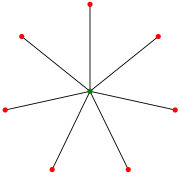| Star | |
|---|---|
 The star S7. (Some authors index this as S8.) | |
| Vertices | k + 1 |
| Edges | k |
| Diameter | 2 |
| Girth | ∞ |
| Chromatic number | 2 |
| Chromatic index | k |
| Properties | Edge-transitive Tree Unit distance Bipartite |
| Notation | Sk |
| Table of graphs and parameters | |
In graph theory, a star Sk is the complete bipartite graph K1,k : a tree with one internal node and k leaves (but no internal nodes and k + 1 leaves when k ≤ 1). Alternatively, some authors define Sk to be the tree of order k with maximum diameter 2; in which case a star of k > 2 has k − 1 leaves.
A star with 3 edges is called a claw.
The star Sk is edge-graceful when k is even and not when k is odd. It is an edge-transitive matchstick graph, and has diameter 2 (when l > 1), girth ∞ (it has no cycles), chromatic index k, and chromatic number 2 (when k > 0). Additionally, the star has large automorphism group, namely, the symmetric group on k letters.
Stars may also be described as the only connected graphs in which at most one vertex has degree greater than one.
YouTube Encyclopedic
-
1/3Views:3 505899391 768
-
What are Star Graphs? | Graph Theory
-
TYPES OF GRAPHS | STAR GRAPH | CYCLIC GRAPH | CYCLE GRAPH | GRAPH THEORY | DISCRETE MATHEMATICS |
-
INTRODUCTION to GRAPH THEORY - DISCRETE MATHEMATICS
Transcription
Relation to other graph families
Claws are notable in the definition of claw-free graphs, graphs that do not have any claw as an induced subgraph.[1][2] They are also one of the exceptional cases of the Whitney graph isomorphism theorem: in general, graphs with isomorphic line graphs are themselves isomorphic, with the exception of the claw and the triangle K3.[3]
A star is a special kind of tree. As with any tree, stars may be encoded by a Prüfer sequence; the Prüfer sequence for a star K1,k consists of k − 1 copies of the center vertex.[4]
Several graph invariants are defined in terms of stars. Star arboricity is the minimum number of forests that a graph can be partitioned into such that each tree in each forest is a star,[5] and the star chromatic number of a graph is the minimum number of colors needed to color its vertices in such a way that every two color classes together form a subgraph in which all connected components are stars.[6] The graphs of branchwidth 1 are exactly the graphs in which each connected component is a star.[7]

Other applications
The set of distances between the vertices of a claw provides an example of a finite metric space that cannot be embedded isometrically into a Euclidean space of any dimension.[8]
The star network, a computer network modeled after the star graph, is important in distributed computing.
A geometric realization of the star graph, formed by identifying the edges with intervals of some fixed length, is used as a local model of curves in tropical geometry. A tropical curve is defined to be a metric space that is locally isomorphic to a star-shaped metric graph.
See also
- Star (simplicial complex) - a generalization of the concept of a star from a graph to an arbitrary simplicial complex.
References
- ^ Faudree, Ralph; Flandrin, Evelyne; Ryjáček, Zdeněk (1997), "Claw-free graphs — A survey", Discrete Mathematics, 164 (1–3): 87–147, doi:10.1016/S0012-365X(96)00045-3, MR 1432221.
- ^ Chudnovsky, Maria; Seymour, Paul (2005), "The structure of claw-free graphs", Surveys in combinatorics 2005 (PDF), London Math. Soc. Lecture Note Ser., vol. 327, Cambridge: Cambridge Univ. Press, pp. 153–171, MR 2187738.
- ^ Whitney, Hassler (January 1932), "Congruent Graphs and the Connectivity of Graphs", American Journal of Mathematics, 54 (1): 150–168, doi:10.2307/2371086, hdl:10338.dmlcz/101067, JSTOR 2371086.
- ^ Gottlieb, J.; Julstrom, B. A.; Rothlauf, F.; Raidl, G. R. (2001). "Prüfer numbers: A poor representation of spanning trees for evolutionary search" (PDF). GECCO-2001: Proceedings of the Genetic and Evolutionary Computation Conference. Morgan Kaufmann. pp. 343–350. ISBN 1558607749.
- ^ Hakimi, S. L.; Mitchem, J.; Schmeichel, E. E. (1996), "Star arboricity of graphs", Discrete Math., 149: 93–98, doi:10.1016/0012-365X(94)00313-8
- ^ Fertin, Guillaume; Raspaud, André; Reed, Bruce (2004), "Star coloring of graphs", Journal of Graph Theory, 47 (3): 163–182, doi:10.1002/jgt.20029.
- ^ Robertson, Neil; Seymour, Paul D. (1991), "Graph minors. X. Obstructions to tree-decomposition", Journal of Combinatorial Theory, 52 (2): 153–190, doi:10.1016/0095-8956(91)90061-N.
- ^ Linial, Nathan (2002), "Finite metric spaces–combinatorics, geometry and algorithms", Proc. International Congress of Mathematicians, Beijing, vol. 3, pp. 573–586, arXiv:math/0304466, Bibcode:2003math......4466L
